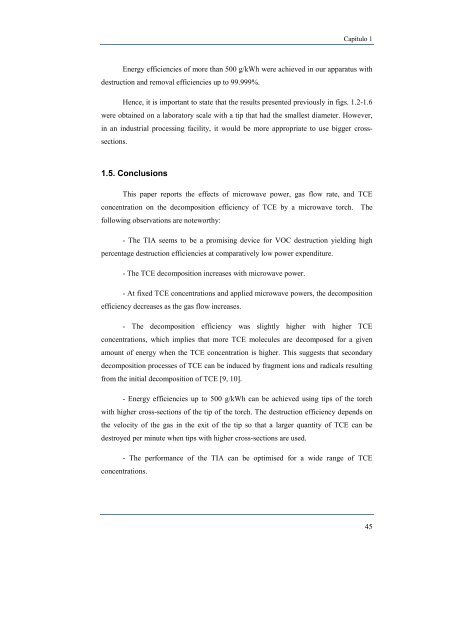estudio y caracterización de un plasma de microondas a presión ...
estudio y caracterización de un plasma de microondas a presión ...
estudio y caracterización de un plasma de microondas a presión ...
You also want an ePaper? Increase the reach of your titles
YUMPU automatically turns print PDFs into web optimized ePapers that Google loves.
Capítulo 1<br />
Energy efficiencies of more than 500 g/kWh were achieved in our apparatus with<br />
<strong>de</strong>struction and removal efficiencies up to 99.999%.<br />
Hence, it is important to state that the results presented previously in figs. 1.2-1.6<br />
were obtained on a laboratory scale with a tip that had the smallest diameter. However,<br />
in an industrial processing facility, it would be more appropriate to use bigger cross-<br />
sections.<br />
1.5. Conclusions<br />
This paper reports the effects of microwave power, gas flow rate, and TCE<br />
concentration on the <strong>de</strong>composition efficiency of TCE by a microwave torch. The<br />
following observations are noteworthy:<br />
- The TIA seems to be a promising <strong>de</strong>vice for VOC <strong>de</strong>struction yielding high<br />
percentage <strong>de</strong>struction efficiencies at comparatively low power expenditure.<br />
- The TCE <strong>de</strong>composition increases with microwave power.<br />
- At fixed TCE concentrations and applied microwave powers, the <strong>de</strong>composition<br />
efficiency <strong>de</strong>creases as the gas flow increases.<br />
- The <strong>de</strong>composition efficiency was slightly higher with higher TCE<br />
concentrations, which implies that more TCE molecules are <strong>de</strong>composed for a given<br />
amo<strong>un</strong>t of energy when the TCE concentration is higher. This suggests that secondary<br />
<strong>de</strong>composition processes of TCE can be induced by fragment ions and radicals resulting<br />
from the initial <strong>de</strong>composition of TCE [9, 10].<br />
- Energy efficiencies up to 500 g/kWh can be achieved using tips of the torch<br />
with higher cross-sections of the tip of the torch. The <strong>de</strong>struction efficiency <strong>de</strong>pends on<br />
the velocity of the gas in the exit of the tip so that a larger quantity of TCE can be<br />
<strong>de</strong>stroyed per minute when tips with higher cross-sections are used.<br />
- The performance of the TIA can be optimised for a wi<strong>de</strong> range of TCE<br />
concentrations.<br />
45

















